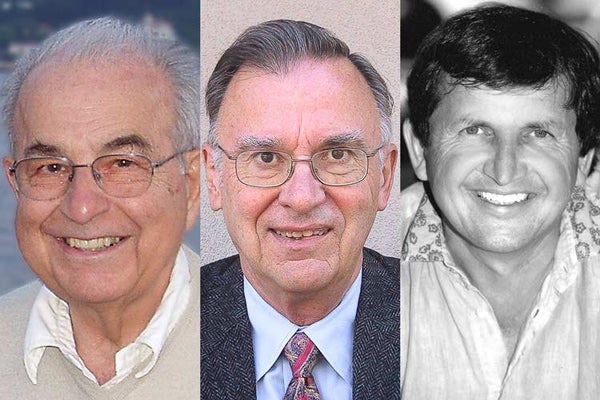 |
November 11, 2014
Three innovators named Stanford engineering heroes
Distinguished Stanford engineers are honored for their impact on our lives and the world. By Jamie Beckett

Andreas Acrivos, left, Marcian "Ted" Hoff and Charles Simonyi have been named Stanford Engineering Heroes for 2014.
The architect of the first microprocessor, the co-creator of the first WYSIWYG, and a professor who helped transform the field of chemical engineering have been named Stanford Engineering Heroes.
The honor recognizes professional achievements that have advanced social and economic progress and improved the human condition. Today's announcement by Persis S. Drell, the Frederick Emmons Terman Dean of the School of Engineering, brings to 32 the number honored since the program began in 2010.
Because engineers often work behind the scenes, the Engineering Heroes program aims to highlight the profound effect engineering has on our everyday lives and to inspire the next generation of engineers.
The 2014 Engineering Heroes are:
- Marcian "Ted" Hoff, whose 1971 invention of the Intel 4004 microprocessor helped lay the foundation for personal computing and a plethora of smaller-faster-cheaper electronic devices.
- Charles Simonyi, who co-created the Bravo WYSIWYG (What You See Is What You Get) text editor in 1974 when he was at the legendary Xerox PARC, and who later became the chief architect of Microsoft Word, Excel and other widely used programs.
- Andreas Acrivos, the first chemical engineer to be honored as a Stanford Engineering Hero, whose research on the flow of viscous fluids had important applications in petroleum recovery and on the field of microelectronics.
Drell said, "Engineers use their knowledge and skills to make our lives easier and better, and sometimes their inventions change the world. They wouldn't call themselves heroes, but they are."
Simonyi and Acrivos join a select group that includes Internet pioneer Vint Cerf, former U.S. Secretary of Defense Bill Perry, astronaut Sally Ride, Google founders Sergey Brin and Larry Page, GPS creator Brad Parkinson, Nobel Prize-winning economist Kenneth Arrow, Hewlett-Packard founders Bill Hewlett and Dave Packard, and Fred Terman, the former Stanford Engineering dean who pioneered the close collaborations between research and industry that became the Silicon Valley way.
The recipients are chosen from among Stanford engineering alumni and former faculty by a panel of subject-matter experts and technology historians. Additional biographical details are below.
Andreas Acrivos is an internationally recognized educator and researcher who has had a transformative impact on chemical engineering, especially in the areas of fluid mechanics, heat and mass transfer. His research on the flow of viscous fluids made it possible to model, analyze and engineer chemical and fluid processes – with applications in numerous industries, including petroleum recovery and microelectronics. Upon receiving his doctorate from the University of Minnesota in 1954, Acrivos joined the chemical engineering faculty at the University of California, Berkeley. He was recruited by Stanford in 1962 as a professor of chemical engineering and was instrumental in transforming that department into one of international stature. In 1988, after accepting one of New York state's Albert Einstein Chairs in Science and Engineering, he took early retirement from Stanford and joined the City College of the City University of New York as a professor of chemical engineering and director of the Levich Institute. He returned to Stanford in 2007 and is associated with the Flow Physics and Computational Engineering group of the Mechanical Engineering Department. He has received numerous awards from engineering and scientific organizations in the United States, including the 2001 National Medal of Science, and is an elected member of the National Academy of Engineering, the National Academy of Sciences and the American Academy of Arts and Sciences.
Marcian "Ted" Hoff is best known as the architect of the first microprocessor, Intel's 4004, released in November 1971. He devised the idea that if the architecture could be constructed simply, the memory, calculating and processing functions of a computer could be combined into one circuit instead of many custom-designed circuits. The Intel 4004 paved the way for many subsequent breakthroughs in personal computing, communications and the Internet. He was the first Intel Fellow, the highest technical position in the company. He is a U.S. National Medal of Technology and Innovation winner, a recipient of the IEEE/RSE Wolfson James Clerk Maxwell Award, and a Fellow of the Computer History Museum. He has also been named to the National Inventors Hall of Fame. Hoff attended Stanford as a National Science Foundation Fellow and holds both a master's degree and a doctorate in electrical engineering.
Charles Simonyi is a high-tech pioneer, philanthropist and space traveler. He is co-creator of the first WYSIWYG text editor (Bravo) and was the chief architect of Microsoft Word, Excel and other widely used application programs. He is founder and CTO of Intentional Software, a maker of software to support idea generation and presentation. He was the fifth space tourist, and the first tourist to fly twice. He is a member of the U.S. National Academy of Engineering and the American Academy of Arts and Sciences; a correspondent member of the Hungarian Academy of Sciences; and chairman of the board of trustees of the Institute for Advanced Study in Princeton, N.J. He holds a bachelor of science degree in engineering mathematics from the University of California, Berkeley, and a doctorate in computer science from Stanford. He and his wife, Lisa, have made numerous philanthropic contributions supporting the arts and sciences as well as other charitable causes worldwide.
For more Stanford experts on engineering and other topics, visit Stanford Experts.
-30-
|
 |